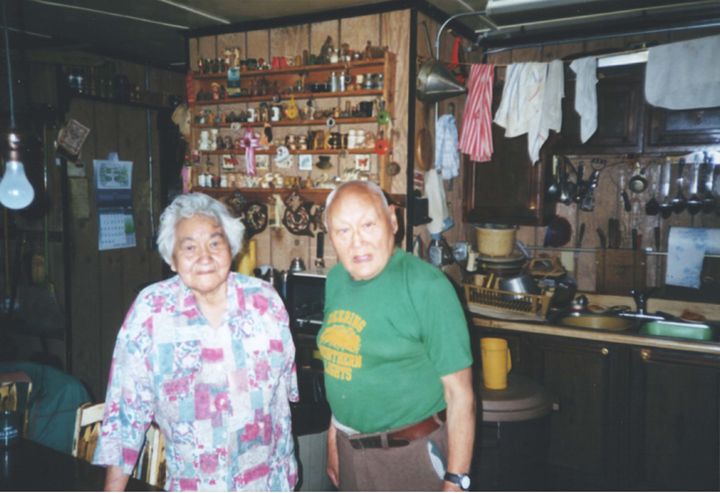___

FLORA AND EVANS KARMUN, OF DEERING, ALASKA
Part 1, The Background
The following articles are written with thanks to the extended families of Flora Paniyak and Evans Karmun, an amazing couple in northwestern Alaska that I had the honor of knowing and sharing friendship with. As a result, the 380-page manuscript, ‘Come On In’ was compiled by the author in 2003.
OVERALL PURPOSE AND MESSAGE
In 1999-2000, while Americans were concerned that Y2K would destroy computer systems nationwide or even further, I took a post as a teacher in the northwestern Arctic village of Deering - located about 135 miles northeast of Nome, Alaska or 58 miles south of Kotzebue. While there, I had a profound experience being welcomed into an Alaska Native community and experiencing culture firsthand from a couple there, Flora and Evans Karmun, who quickly became good friends. As a lifelong educator, I want to share some important lessons from that experience for the reader.
There have been many well-known strides in Alaskan history such as the discovery of gold in 1899, the discovery of oil in Prudhoe Bay in 1967, and the inspiring passage of the Alaska Native Claims Settlement Act in 1971. But as much as the news of these experiences splashed across newspapers or even windswept slopes from the time of the Klondike to the present, there are deeper lessons waiting to be learned. Lessons of friendship, perseverance, and dedication, and of care, humor, and warmth.
It was with this in mind that in 1999 I set off on jet plane bound from Anchorage to Kotzebue and then after that a small plane headed to Deering. It was one of several trips I would make over the coming months and years.

The Location of Deering, Alaska (517 miles northwest of Anchorage, Alaska)
BACKGROUND
When I got to the village of Deering in late August, so also did 27 boxes of food that I had mailed there courtesy of the US Postal Service subsidized mailing rates to distant Alaskan villages, of which there are 208 across the state. About 150 people lived in Deering at the time though it and 9 other villages were just dots on a landscape the size of Minnesota! The school had in upwards of 50 children, from K-12, and I was a teacher of grades 7-12 math, science, journalism, and health.
After settling in and renting an apartment thanks to one of the village residents, I unpacked. Then I had a thought that I simply describe as the reason for writing the manuscript, Come On In. Since there were about 12-15 elders (the local name for older people in rural Alaska) in the village of only a few dozen houses, I wondered how I would develop a bridge of friendship. With that in mind, I thought of what my mom always did when I was growing up in Western New York state. She would bake loaves and loaves of bread - pumpkin bread, banana bread, and zucchini bread - and give it to neighbors when holidays or other festive occasions were coming. And so, I got out my bread making machine and the many boxes of bread that came in the mail. Then I got to work as a baker!
Across a morning and afternoon, I made a half dozen or so loaves of bread - poppy seed, banana, and the like - and then set off across the village. Since it was still August, it was warm. I could get by only wearing a vest or simple sweatshirt depending on the time of day. And so I went across the village in search of the houses where elders lived. Door to door. Heart to heart. Home to home.
Some doors creaked open slowly hiding the frame of a soft-spoken person quizzically asking what I wanted. Some doors did not open yet a voice called from within. Still others opened, and somewhat quickly closed. Even a couple doors did not open at all. Still, I came offering a loaf of bread, or a half a loaf, and simply wanted to share my name and that I was a new teacher in the village.
And then it happened. I got to the house of Flora and Evans Karmun.
CHANGING THE HEART OF A TEACHER
As I clutched a loaf of bread and tapped on their door, a number of thoughts were likely swirling around. Would I be welcomed? Would the door open? Would the pathway towards cultural friendship be trod upon, or not?
And as I pondered these things albeit briefly, a voice hollered from inside with a sound of kindness in its timbre. It was Flora Karmun, and she called out loudly “Come In” to whomever came to her door.
I opened the door and walked in quite hesitantly. It was the first house I actually had done more than just stand in the doorway. And now I was inside. I smiled and so did they. Questions about my teaching and when I had arrived began. Then conversation took off. Soon coffee was offered and then more conversation. It was like close friends meeting for the first time.
That day, I was surprised to be welcomed into an Alaska Native household. Even more so, I was surprised at being welcomed as a teacher and as a cultural ambassador. I’d be overstating the purpose and intent of this first meeting with the Karmuns if it weren’t for one thing. After a wonderfully engaging, uplifting, and insightful 45 minutes or so of conversation, there came a point when I knew that the evening was coming and the Karmuns had dinner to get on the stove. As our impromptu yet enjoyable meet-up drew to a close, I said some pleasantries, expressed thanks for their hospitality, and possibly waited as they would surprise me for the second time that day! But how, you might be wondering.
As I had initially made the rounds in this small village hoping to build a platform on which to teach some of the community’s children, I had not actually anticipated being welcomed to a great degree. I was hopeful, but had no idea what would occur. Perhaps my lack of a positive expectation was simply a reality check in my heart I had learned elsewhere - and I did not want to be overly enthusiastic. But the Karmuns set me straight in that they welcomed me into their home, they shared, they laughed, and they found room in their hearts and lives for me.
It was a lesson that carries on to this day. Wherever I am in life, I work to see the culture or cultures that are present and to be a cultural ambassador of friendship, good will, and gratitude to them.
Surprisingly, this is exactly what I learned from Flora and Evans on that first day I met them. And the reason for this surprising insight was as simple as it was visible that day.
As I walked towards their door to leave in much the same way as I had come, I heard a voice just like before. Instead of hearing ‘Come in,’ however, I heard this heartwarming phrase that I would soon get used to.
As one of the Karmuns was smiling, the other spoke up and said, “See you next week.”
And so began a friendship that spanned across generations of oral tradition in northwestern Alaska, from friendships with Russians, to the Bering Strait, to Reindeer, to Oil’s Discovery, and to Raising an Amazing and Resilient Family.
In Part 2 of this series, I will discuss the topic of “Changing the Heart of a Culture” and in Part 3, “Changing the Heart of People when Errors were made.”
***
Dr. Jonathan Doll lived in Alaska from 1998 to 2004 and earned his Masters Degree from the University of Alaska in Anchorage. He credits the opening door to friendship and the wealth of knowledge he learned in the Karmun household to the sage wisdom of UAA Professor Stephen Haycox, who taught the class, Alaska History. Dr. Doll wrote the book Ending School Shootings (2015) after a 2013 school shooting in Centennial, Colorado and lives in Dubai with his wife Laura.
*******
